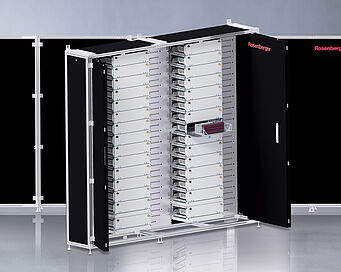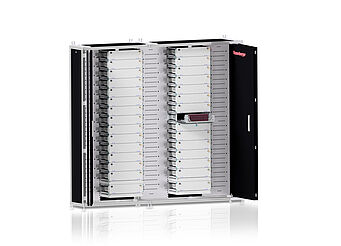Patch Location Rack COMFORT - Reliability and ease-of-use combined with high packing density. I have asked my colleague Ronny Mees here to talk about this issue. Can you introduce us to the new Patch Location Rack COMFORT?
Ronny Mees: Why am I showing you this new Patch Location Rack COMFORT today? I’m showing it to you because it’s a great product for supporting the transformation that we are currently seeing in data centers. Densification in data centers is an important topic. But there are also other issues, such as saving energy in data centers.
How do we help with our Patch Location Rack COMFORT?
Ronny Mees: At first glance you might say ‘all right, but that’s just cabling. How is that supposed to help save energy? If you think about the cold aisles in a data center. The cold aisles are where the servers are, the switches, and so on. They are actively cooled. In the past, an awful lot of energy has been invested in them. I’m talking about mental energy to think about ways to make all this more efficient.There are the cold aisles and now there is also a fabulous controller for the cooling temperature.And that naturally ensures energy efficiency.But in the past, something was done which, in my opinion, was less efficient. The cabling was all packaged in there as well. So they were cooling things that didn’t actually need to be cooled. And that’s what we’re trying to change here. That means getting the passive cabling, the passive infrastructure out and away from the cold aisles. That’s the background.
It can actually be seen in the rack itself. It’s 40 centimetres deep and 2.40 metres wide and has a footprint of just under one square metre. And now you can get a lot of LC-Duplex ports in there. More than 4600 LC-Duplex ports in the rack. And you can position it wherever you want, at the side, next to the wall. A low space requirement and you can position it where space is available. So not in the cold aisle. If possible, either at the start of the cold aisle containment or at the side of the data center. Or even in a separate room. Some data center providers have a separate room for this.
Let’s take a look inside the Patch Location Rack COMFORT.
Ronny Mees: Let’s open the rack. It’s very well thought-through, as you can see from this door. The door is a folding door. What advantages does that have? Thanks to this folding door, I can get to the internal equipment incredibly easily. And if I need regular access to the unit, for example, I don’t have to move the door away somewhere. It often happens that colleagues in the service teams who are doing patching say that it gets in the way, that they have to move it somewhere into the corridor. That can be a source of accidents. And that’s what we have avoided here.
Let’s open the second door. And here we can see very nicely how it’s all structured. The trunk cables arrive from the sides, from the left or right. They are attached using the trunk cable divider holders. And the trunk connector legs then lead into this patch panel. If we pull this patch panel out a little, we can see that it has a very, very high connector density. We have 144 LC-Duplex ports here. And to get to these without interrupting anything, we have chosen plug connectors with a so-called push-pull boot. This means that you can pull them out at the boot and because the boot is somewhat flexible, you can easily get right down to the bottommost ones here.
And maybe one more point about the cabling. The patchcords are routed via this guide here and the guide always moves with them a little. And that helps reduce the strain on the cable. So a bundle of cables like this also has 144 cables, which is quite a lot. And of course you have to make sure that you don’t break anything when you’re patching. So that’s the most important information about this patch module.
We also have a splice module here. At first glance, it looks exactly like a patch module. But if we open it up, you can see the splice cassettes in the area at the back. And this is all done very neatly as you can see when you look at the side here. A flexible tube is fixed here to guide the cables and is routed into a drawer below. The cable is supported here and the fibers are guided up through the flexible tube to the splice cassettes.
It is possible to install up to 16 patch modules per side, i.e. 32 in a double rack. The number of splice modules is a little lower because you always need some space for the cable support. And so we can offer customers the right Patch Location Rack for them, individually tailored to their specific needs. The holders for excess lengths can be arranged very flexibly. Trunk cable divider holders as an accessory. There’s nothing else we need.
In the modules, we’ve always seen LC plug connectors. Does the Patch Location Rack COMFORT also exist with other connector faces?
Ronny Mees: Yes, we can supply the COMFORT Patch Location Rack with various connector faces, including in a mixed configuration if required. There is currently very great interest in US Conec MDC plug connectors. And also Senko SN® plug connectors. Both of them offer a crucial advantage. They have an even higher packing density.
How many ports are we talking about per module?
Ronny Mees: For each patch module, we have up to 288 duplex ports. That means that this adds up to about 9200 ports in the rack. And still, by way of a reminder, with a footprint of not even one square metre.
More information on the subject of Patch Location Rack COMFORT can be found here.




